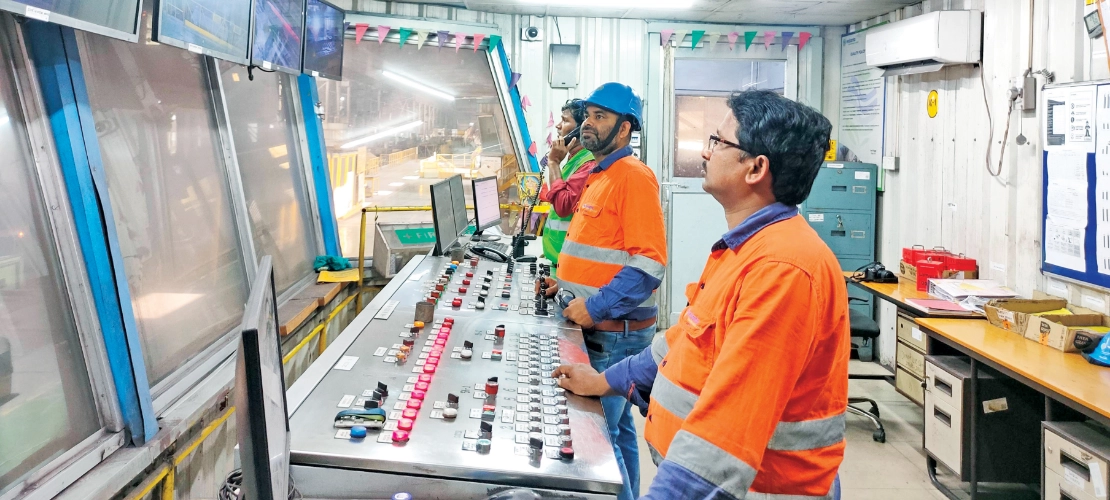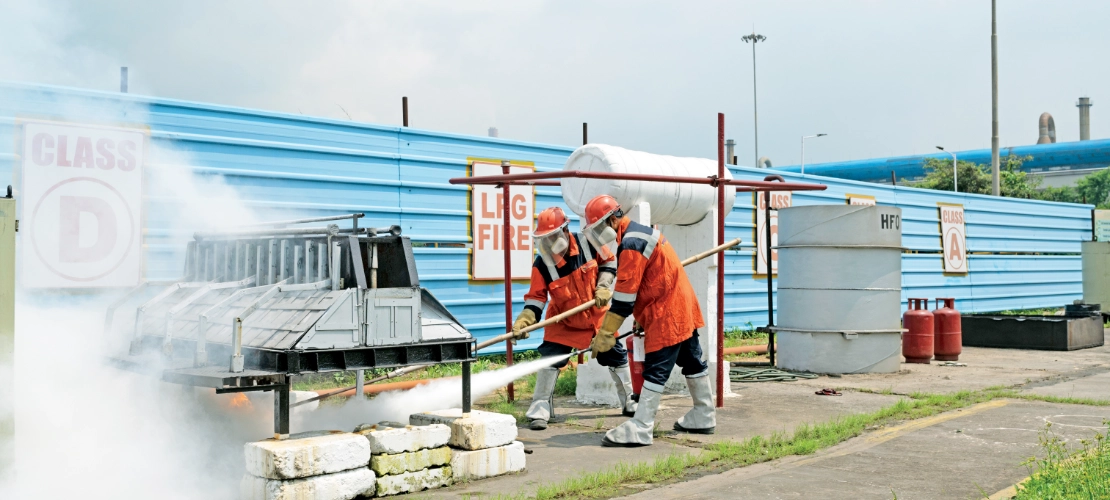Risk ManagementProactively managing risks and
opportunities

We have implemented a robust, multi-layered risk management
system supported by a strong governance framework to identify, assess, monitor, and mitigate
risks across our global operations. Integrated into our decision‑making and business
strategy, it ensures effective execution even in dynamic environments. The system is
continuously monitored and adapted to address emerging risks, ensuring agility and
resilience. Risk management is embedded at all levels, with active involvement from key
stakeholders, promoting alignment across the organisation. This holistic approach safeguards
our long-term success while allowing us to navigate and respond effectively to both
challenges and opportunities.
Risk Governance Framework

Group Risk Governance Framework

Enterprise risk management
Our risk management framework is embedded in critical business
functions, enabling us to manage, rather than eliminate, risks to achieving
objectives. By balancing materiality and risk tolerance, it ensures reasonable
assurance against significant losses. The system is straightforward and consistent,
offering clarity in reporting risks to the Board. Together with our management
systems, processes, and ethical standards, it governs our approach to managing
business risks.
Risk heat map
Heatmap represents residual risk profile
- Both inherent risk and residual risk increased in October 2024
for “Stability of tailing dams”
- Inherent risk for “Access to capital” decreased in
October 2024
Approach to risk identification
We identify risks at the business level for both existing operations and
ongoing projects using a consistent methodology. Regular quarterly business-level review
meetings are held to formally discuss risk management, where risks are assessed, reviewed,
and decisions on actions are made.
Risk identification process

- Risks are identified at the business level for
operations and projects
- A consistent methodology is applied across all
divisions
- Quarterly review meetings formally discuss risk
management
Risk review and control

- Each business maintains a risk matrix, reviewed by
the management/executive committee, chaired by the CEO
- Risks, exposures, and control measures are
regularly reviewed
- CEOs, CXOs, senior management, and functional heads
participate in the reviews
Aggregation and evaluation

- Risks from various registers are aggregated to
identify the Group’s principal risks
- This process is key to the internal control system,
with the Board receiving assurance on the framework
Risk governance
At both business and Group levels, risk officers are responsible for
promoting risk awareness and cultivating a risk management culture. Risk-mitigation plans
are embedded into the Key Result Areas (KRAs) and Key Performance Indicators (KPIs) of
process owners, ensuring integration of risk management into daily business activities.
Role of risk officers

- Foster risk awareness and build a risk management culture
across the Group
- Integrate risk mitigation plans into process owners' KRAs and
KPIs
Committee roles

- The Audit & Risk Management Committee (ARMC) supports the Board
by assessing risk exposure, reviewing controls and approving necessary remedial
actions
- The Group Risk Management Committee (GRMC) evaluates the
effectiveness of the risk mitigation programme and control systems
- The Risk Management Committee meets periodically to discuss
risks and mitigation measures, review the robustness of our framework and map the
progress against actions planned for key risks.
Board responsibilities

- The Board oversees risk management, reviewing ARMC reports on
risks, controls, and weaknesses
- Identified weaknesses are addressed by enhancing procedures and
strengthening controls
Key committees

- Committee of Directors (COD): Reviews and approves
borrowing and investment proposals.
- The invitees to these committee meetings are the CEO, business
CFOs, Group Head Treasury and BU Treasury Heads, depending upon the agenda matters.
- Audit and Risk Management Committee: Reviews
sustainability-related risks
- Group-level Committees (ManCom): Address risks in areas
such as commercial, finance, sustainability, and corporate social responsibility
Internal audit
The scope of work, authority and resources of the Management
Assurance Services (MAS) are regularly reviewed by the Audit Committee. The
responsibilities of MAS include recommending improvements in the control environment
and reviewing compliance with our philosophy, policies and procedures.
Internal audit planning is approached from a risk perspective.
Inputs are gathered from senior management, business teams, and the Audit Committee,
ensuring that audits are aligned with the identified risks. This process also
considers financial analysis and the current economic and business environment to
ensure the most relevant risks are addressed.
Audit planning
- Internal audits are based on the risk matrix and senior
management inputs
- Planning includes financial analysis, past audits, and
the current business environment
- The Audit Committee ensures audits address critical
risks
FY 2024-25 risk trend
 Risk
decrease (Y-o-Y)
Risk
decrease (Y-o-Y)
 Risk
unchanged (Y-o-Y)
Risk
unchanged (Y-o-Y)
 Risk
increase (Y-o-Y)
Risk
increase (Y-o-Y)
Managing our risks
The key risks identified for FY 2024-25, which may impact our
operations, are listed below. The order does not reflect their likelihood or
potential impact on Vedanta’s businesses. Each risk has been reviewed based on
events, economic conditions, the business environment, and regulatory changes during
the year.
SUSTAINABILITY RISKS
HEALTH, SAFETY, AND ENVIRONMENT (HSE) 
Capitals at risk

Potential impact on the Group

We must comply with strict health, safety, and environmental (HSE)
regulations, which are expected to tighten over the next decade. Environmental damage
and climate change mitigation failure are among the top risks in the World Economic
Forum Global Risk Report 2025.
Our global presence exposes us to emission regulations, which could
increase costs, levies, litigation, and administrative expenses. Stricter greenhouse gas
(GHG) regulations, including carbon trading and emission reduction targets, may further
raise costs and reduce demand.
Mitigating actions

Prioritising Health, Safety, and Environment (HSE)
- Safety First Culture: Complying with global
regulations to protect people, communities, and the environment while minimising
HSE-related business disruptions
- Robust management systems: Developed policies to
mitigate HSE risks, through regular reviews and reporting, focussing on
high-risk areas
- Leadership by example: Promoting "visible felt leadership"
on safety by site leaders, overseeing critical tasks and business partner HSE
performance
- Improving incident investigations and learning to prevent
recurrence
Sustainability
- Aligning sustainability framework with global standards,
ensuring HSE, community relations, and human rights coverage
- Adhering to comprehensive health and safety policies,
supported by structured processes, controls and technology to ensure employee
well-being
- Integrating safety KPIs into performance evaluations,
incentivising safe behaviour and effective risk management
Climate change action
- Developing and recommending carbon reduction strategies by
our Carbon Forum to the Executive Committee and Board.
- Increasing reliance on renewable energy to meet power
demand
- Reducing GHG emission intensity across operations
- A dedicated task force evaluates requirement of FGD plants
for further emission reduction, engaging with stakeholders on emission control
solutions
MANAGING RELATIONSHIPS WITH STAKEHOLDERS 
Capitals at risk

Potential impact on the Group

Our success relies on strong relationships with local communities.
Failing to address their concerns can harm relations, affecting our reputation and
social licence to operate and grow.
Mitigating actions

Building strong stakeholder relationships
We value positive relationships with all stakeholders and adopt a
multi-pronged approach to mitigate risks.
Comprehensive CSR strategy
- Aligning CSR initiatives with the Companies Act, CSR
guidelines, National Voluntary Guidelines, and UN SDGs, prioritise the needs of
local communities and ensuring local development
- Engaging business units with communities through structured
plans, fostering collaboration
- Regular reviews by CSR Management Committee on CSR strategy
and execution. While business level Executive Committees determine focus areas
and budgets
Effective grievance redressal
- All business units follow procedures to record and resolve
grievances, alongside clear social investment processes
Dedicated resources
- Community Development Manager at each unit, supported by a
professional team for consistent engagement and project implementation
Building trust and transparency
- Regular interaction with business leadership teams with
local communities to build trust and mutual benefits
- Identifying and minimising negative impacts, acting
transparently and ethically while adhering to our commitments
Stakeholder engagement and communication
- Enhancing visibility through CSR communication, stakeholder
meetings, showcasing our technological advancements and social media engagement
- Reporting best practices on ESG performance to ensure
transparency and accountability
STABILITY OF TAILINGS DAMS & PROCESS WATER RESERVOIRS 
Capitals at risk

Potential impact on the Group

Mining operations releases waste material that can lead to loss of
life, injuries, environmental damage, and impact production. Tailings dam failure, a
catastrophic but low-frequency event, poses a continuous, high-priority risk with
significant financial and reputational implications.
Mitigating actions

We prioritise tailings dam safety through a multi-pronged approach.
Accountability and continuous improvement
- All business units (BUs) are responsible for managing
tailings facilities, with oversight from the Executive Committee (ExCo)
- Annual third-party assessments ensure best practices are
followed. Every three years, a third party reviews operations, identifies
improvements, and assesses the implementation of Operational Maintenance and
Surveillance (OMS) manuals
- Continue to digitalise our monitoring systems and update
tailings management standards, incorporating the UNEP/ICMM Global Tailings
Standard and other global best practices
Enhanced standards and procedures
- Strengthened the Tailings Management standard with annual
independent reviews of individual damand half-yearly CEO sign offs confirming
adherence to design parameters and the recent surveillance audit
- Prioritising transitioning to dry tailings facilities where
possible
- Regular training facilitated for the Dam management
personnel from third-party experts and international consultants
OPERATIONAL CHALLENGES IN ALUMINIUM AND POWER BUSINESS 
Capitals at risk

Potential impact on the Group

Our operations face challenges such as sourcing raw materials in a
tight market, infrastructure concerns, and issues with ash utilisation and evacuation.
Mitigating actions

We have made significant strides in optimising operations and
positioning ourselves for the future.
Improved margins and production
- Aluminium business achieved record production and improved
EBITDA led by favourable output commodity prices, our focus on operational and
cost efficiencies and increased value-added production
Operational efficiency, vertical integration, and raw
material security
- Increasing Alumina refinery capacity to enhance vertical
integration and ensure raw materials security
- Addressing raw material security by boosting domestic
sourcing and exploring global spot supply options
- Asset Reliability improvements have led to the highest-ever
power load factor (PLF), enhanced operational parameters, and record production
volumes
- Expanding value-added facilities to improve product mix and
increase margins through higher net effective premiums (NEP)
- Introducing captive rakes and shifting from road to rail
transport has improved safety, reduced costs, and enhanced supply security. More
rakes will be deployed in the future
- Partnering with cement companies, NHAI, and Brick
Industries for ash evacuation, implementing mine backfilling. Additionally, we
are in the process of validating the patent for an innovative process to reduce
Red Mud generation and enhance alumina yield
LOSS OF ASSETS OR PROFIT DUE TO NATURAL CALAMITIES 
Capitals at risk

Potential impact on the Group

Exposure to risks such as equipment failure, infrastructure damage,
unexpected geological conditions, technical issues, extreme weather, or natural
disasters may disrupt production and increase costs
Mitigating actions

Insurance management and oversight
- Maintaining comprehensive Group insurance cover, overseen
by the Insurance Council, which monitors coverage, adequacy, and claims
- Engaging reputable institutions to underwrite our risk and
third-party experts to review risk portfolio and ensure sufficient coverage
- Structured mechanism is in place for periodic reviews
across all entities, recognising that uninsured events may still pose a risk
Function monitoring and capability building
- Regular assessing and strengthening effectiveness of our
security and insurance functions
- Ongoing focus on capability building to improve internal
risk management and insurance expertise

COMPLIANCE RISK
FINANCIAL RISK
PRICE (METAL, OIL, ORE, POWER, ETC.), CURRENCY AND INTEREST
RATE VOLATILITY 
Capitals at risk

Potential impact on the Group

Our product prices and demand are influenced by a range of global
uncertainties, including economic, political, environmental, and social factors. In
addition, operating across multiple currencies exposes us to exchange rate fluctuations,
which can impact our earnings, cash flow, and reserves.
Mitigating actions

Ensuring operational resilience
- Mitigating the impact of price volatility through diverse
commodity portfolio
- Focussing on technology, vertical integration, and
operational efficiencies to sustain and improve margins and steady cash flows
across cycles
Deploying effective forex strategies
- Hedging Strategies: While most of our products are sold at
prevailing market prices, we employ back-to-back hedging for custom smelting
arrangements and purchased alumina to mitigate specific commodity risks.
Strategic hedging may also be undertaken, subject to approval by the Executive
Committee
- Foreign Exchange Management: We maintain a strict
no-speculation policy on foreign exchange. However, we actively hedge currency
exposures on a back-to-back basis, particularly for short-term risks. This
approach helps manage volatility and protects against near-term currency
fluctuations. The Finance Standing Committee regularly reviews forex and
commodity risk positions and advises the respective business units on
appropriate mitigation strategies
- Any substantial shifts in foreign exchange rates are
escalated to the Group Management Committee (ManCom). Our approach to foreign
exchange and commodity risk management is governed by well-defined policies,
which are transparently disclosed in the Annual Report



Risk
decrease (Y-o-Y)
Risk
unchanged (Y-o-Y)
Risk
increase (Y-o-Y)

